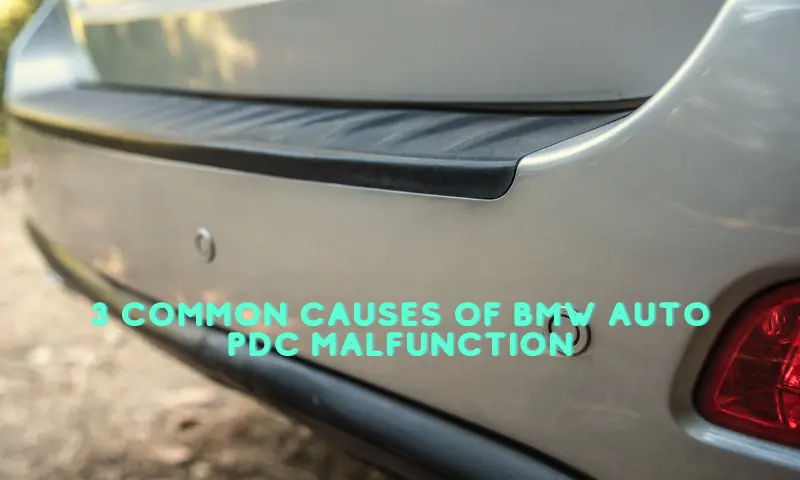A BMW Auto PDC (Park Distance Control) malfunction refers to issues in the parking assistance system that may cause it to not work properly. This system utilizes ultrasonic sensors found in both the front and rear parts of the vehicle, which helps detect the proximity of obstacles when parking or maneuvering in tight spaces. However, certain problems may arise, leading to the display of “Parking Assist Malfunction,” “Auto PDC failure,” or “no parking assistance” on the BMW iDrive screen.
Common causes of BMW Auto PDC malfunctions include faulty sensors, defective control modules, or issues with the wiring harness. When encountering such problems, it’s essential to diagnose the issue accurately and efficiently in order to maintain the smooth operation of the parking assistance system. This often requires the use of a BMW All System scanner to assess the PDC components and identify the root of the malfunction.
Addressing and fixing a PDC malfunction may vary in cost from $30 to $150, depending on the specific cause and the vehicle’s location. Usually, the process of diagnosing and repairing the issue takes about 30 minutes to an hour. With a proper understanding of PDC malfunctions and their possible fixes, BMW owners can ensure optimal performance of their parking assistance system and enhance their overall driving experience.
What is PDC?
Park Distance Control (PDC) is an advanced driver assistance feature designed to make parking easier for vehicle owners. The system uses sensors mounted on the car’s bumpers to detect obstacles and provide real-time feedback to the driver, helping them avoid potential collisions while parking.
For BMW vehicles, PDC is a standard or optional feature on most models, including the X5. The system typically consists of multiple ultrasonic sensors that monitor the space around the vehicle. As the driver approaches an obstacle, the system sends visual and audible signals to indicate the distance, ensuring safe and accurate parking maneuvers.
The PDC system can also be integrated with the car’s iDrive display, providing a visual representation of the vehicle’s surroundings, including any detected obstacles. This feature proves especially helpful in tight parking spots or when maneuvering in areas with low visibility.
In addition to assisting in parking, PDC can also be beneficial while navigating through narrow streets or confined spaces. It enables drivers to have a better understanding of their vehicle’s position relative to other objects, reducing the chances of accidental damage.
How Does It Work?
The BMW Auto PDC (Park Distance Control) is an advanced driver assistance feature designed to make parking in tight spaces easier. It uses sensors and communication with the vehicle’s internal system to provide guidance and ensure safe parking.
Sensors positioned around the vehicle serve as the primary component of the Auto PDC system. These sensors detect obstacles in close proximity to the vehicle and send data to the control unit. The control unit then analyzes the collected data and relays this information to the driver via visual and audible cues, signaling the distance between the car and any obstacles.
Furthermore, the Auto PDC system integrates with the car’s onboard iDrive system, displaying real-time parking data on the screen. This allows the driver to have a clear view of any obstacles, making it even easier to navigate safely.
In some BMW models, the Auto PDC system is also connected to the vehicle’s steering and braking systems, offering semi-autonomous parking assistance. This feature helps the car steer itself into a parking space while the driver controls the accelerator and brake pedals.
When the system is functioning properly, the Auto PDC makes parking safer and more efficient by preventing collisions and helping the driver navigate tight spaces with ease. However, malfunctions can occur, often due to sensor issues or problems with the control unit, which may lead to an Auto PDC malfunction.
Common Causes of PDC Malfunction
In this section, we will discuss the common causes of PDC malfunction in BMW vehicles. These issues often stem from sensor failure, wiring issues, and control module problems.
Sensor Failure
Sensor failure is one of the most common problems leading to a PDC malfunction in BMWs. Faulty sensors may cause inaccurate or unresponsive parking assistance, which can be both frustrating and dangerous for drivers. Dirt, dust, or mud covering the sensors can also lead to their malfunction. To diagnose a sensor issue, activate the system with the button and touch each sensor with your finger. A slight bump is felt when holding a finger over a functioning sensor for a few seconds.
Wiring Issues
Wiring issues can also cause a PDC malfunction in BMWs. A bad wiring harness may lead to non-functional or intermittent functionality of parking assistance systems. It is crucial to inspect the wiring for damage, corrosion or loose connections, after ensuring that the sensors are functioning correctly.
Control Module Problems
Defective control modules or software issues with the Park Assist system may also result in a PDC malfunction. To diagnose this issue, a BMW All System scanner is required to access and analyze the parking assistance system data. Simply plug in the scanner to the OBD-II port under the dashboard and follow the on-screen instructions to select your BMW model and control units.
Signs of PDC Malfunction
A BMW auto PDC (Park Distance Control) malfunction can be easily identified by paying attention to certain signs when trying to park your vehicle. Here are some of the common symptoms to watch out for:
- Error message on dashboard: One clear indication of a PDC malfunction is the appearance of an error message, such as “Auto PDC Malfunction,” on your BMW’s dashboard display.
- Inconsistent or non-responsive sensors: The PDC system relies on sensors to detect obstacles around your vehicle. When these sensors malfunction, they may provide inaccurate or inconsistent data, making uneasy parking situations.
- Audible warnings not working: Typically, the PDC system is designed to emit audible warnings, such as beeps, when getting close to an obstacle. If these warnings are absent or irregular, it might indicate an issue with the PDC system.
- Navigational issues: In some cases, the PDC malfunction may affect the functionality of your BMW’s navigation system or cause problems with the visual parking aid display, making it challenging to park your vehicle.
It’s essential to address a PDC malfunction as soon as possible to ensure you can park your BMW safely and avoid any potential obstacles or collisions while parking.
Repair and Replacement
In this section, we will discuss various methods to address a BMW auto PDC malfunction, including replacing sensors, fixing wiring issues, and changing the control module.
Replacing Sensors
One possible cause of a PDC malfunction is damaged or defective sensors. In some cases, simply cleaning the sensors can fix the problem. However, if they are beyond repair, it’s necessary to replace the malfunctioning sensors. To do so, access the faulty sensor by removing the bumper, disconnect the sensor’s wiring, and install the new one. Ensure that the replacement sensor is compatible with your BMW model.
Fixing Wiring Issues
Another cause of auto PDC malfunction could be a problem with the wiring or the wire harness. According to a guide by Car Auto Repair, if there is damage in the wire harness, it needs to be repaired or replaced, ensuring that the correct wiring diagram is followed. After fixing the wiring issue, apply felt strip to the area on the trailer hitch or vehicle body where the wire harness was damaged to prevent future issues.
Changing Control Module
In some cases, replacing the PDC control module might be necessary to fix a malfunctioning system. The control module is responsible for managing the sensors and displaying the parking data to the driver. To replace it, locate the control module, usually found behind the rear bumper or near the wheel well, and disconnect its wiring. Install a new, compatible control module and make sure that all connections are secure.

